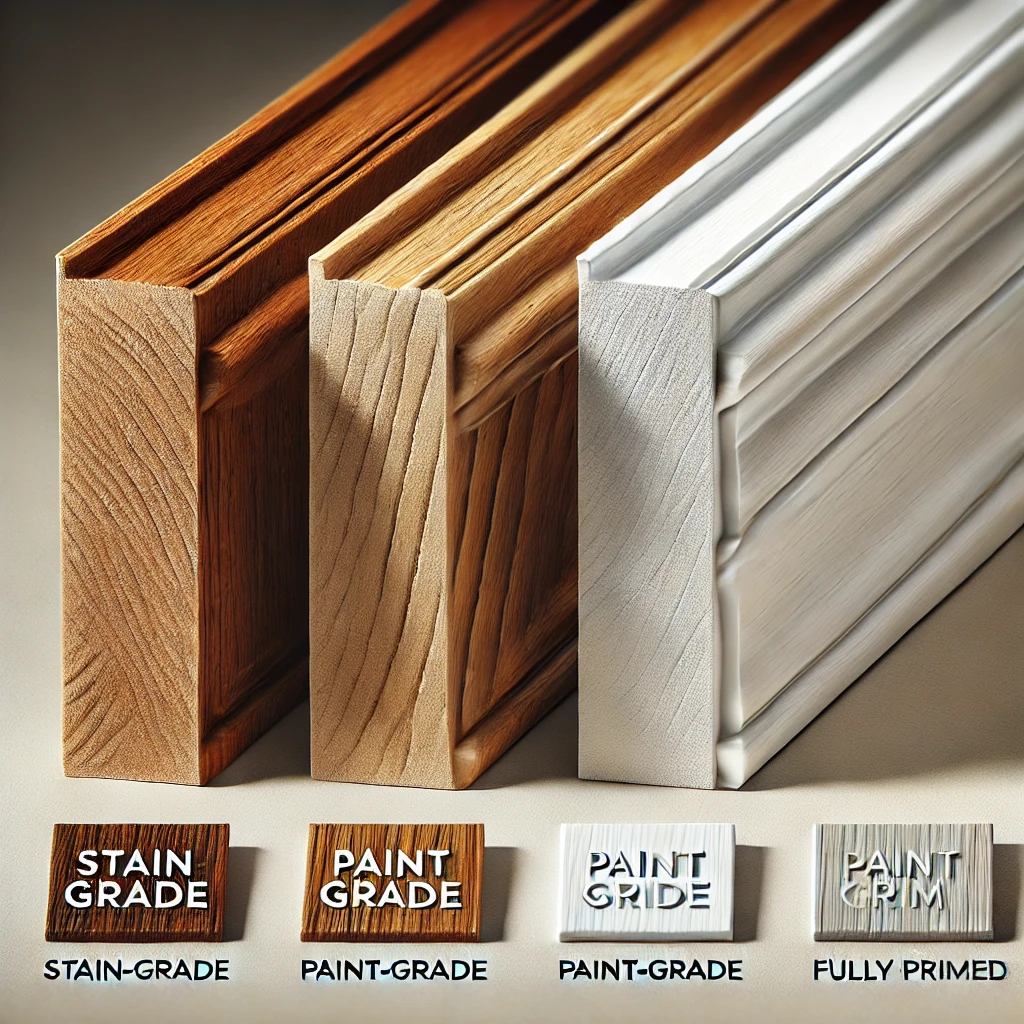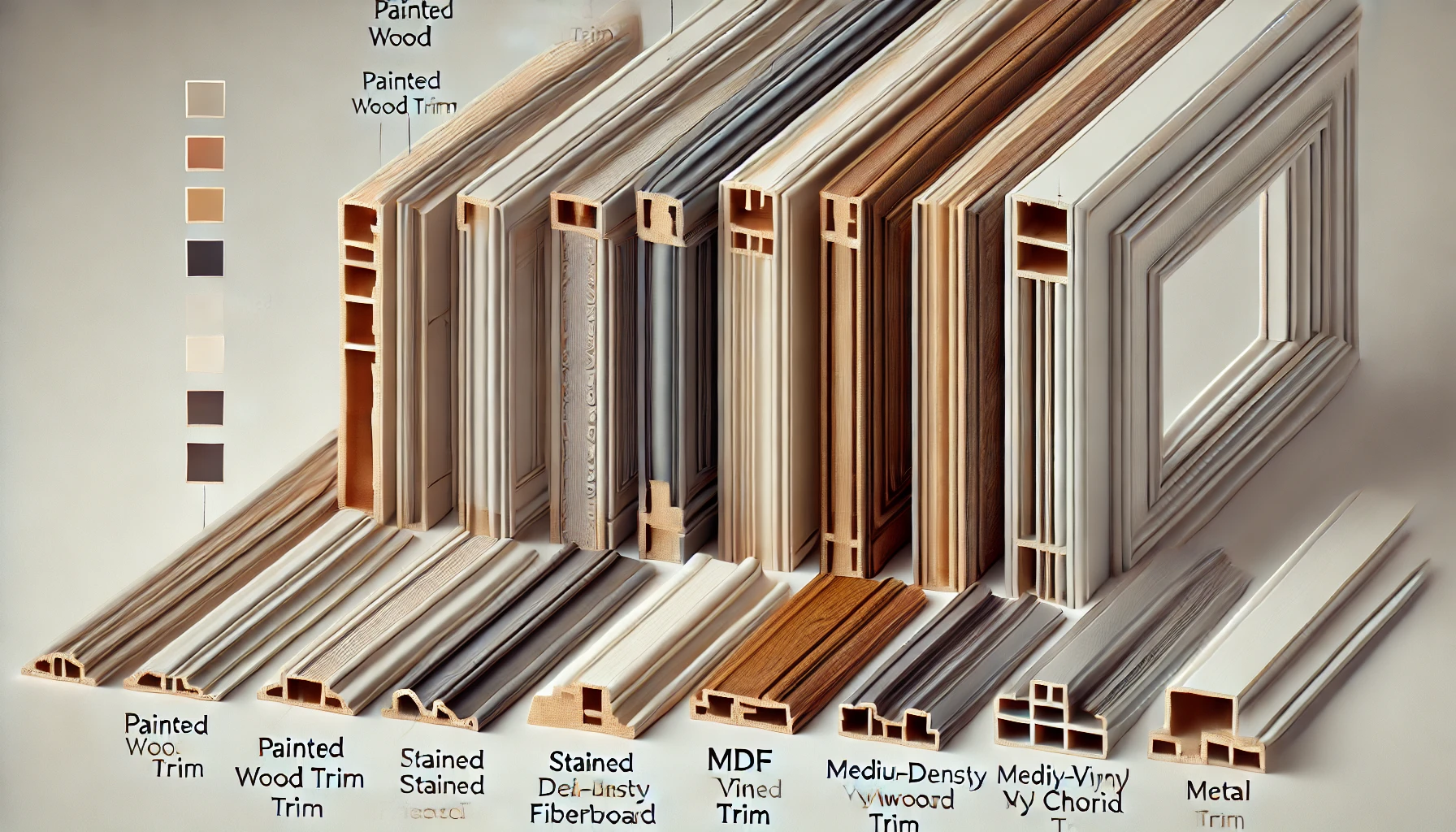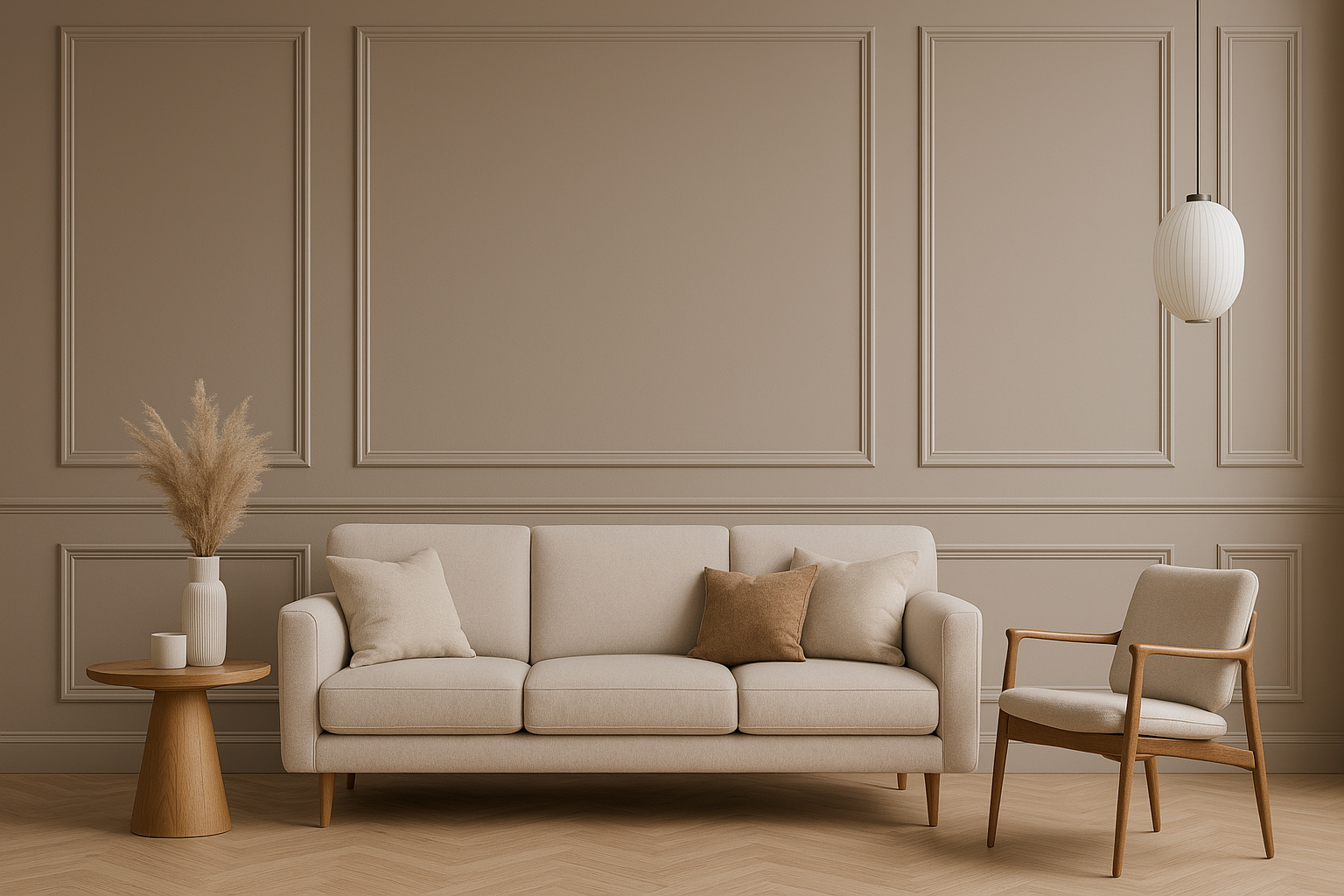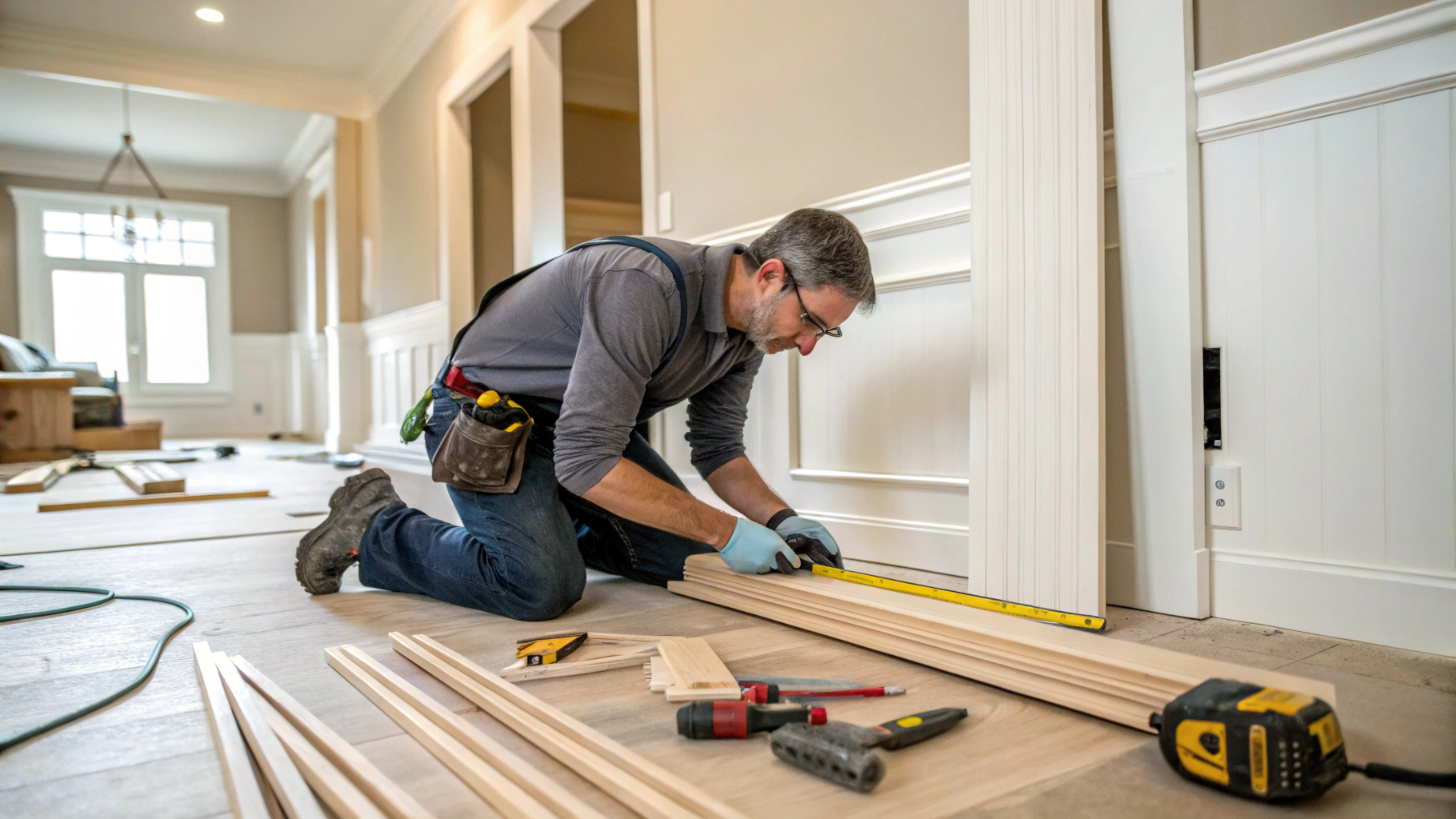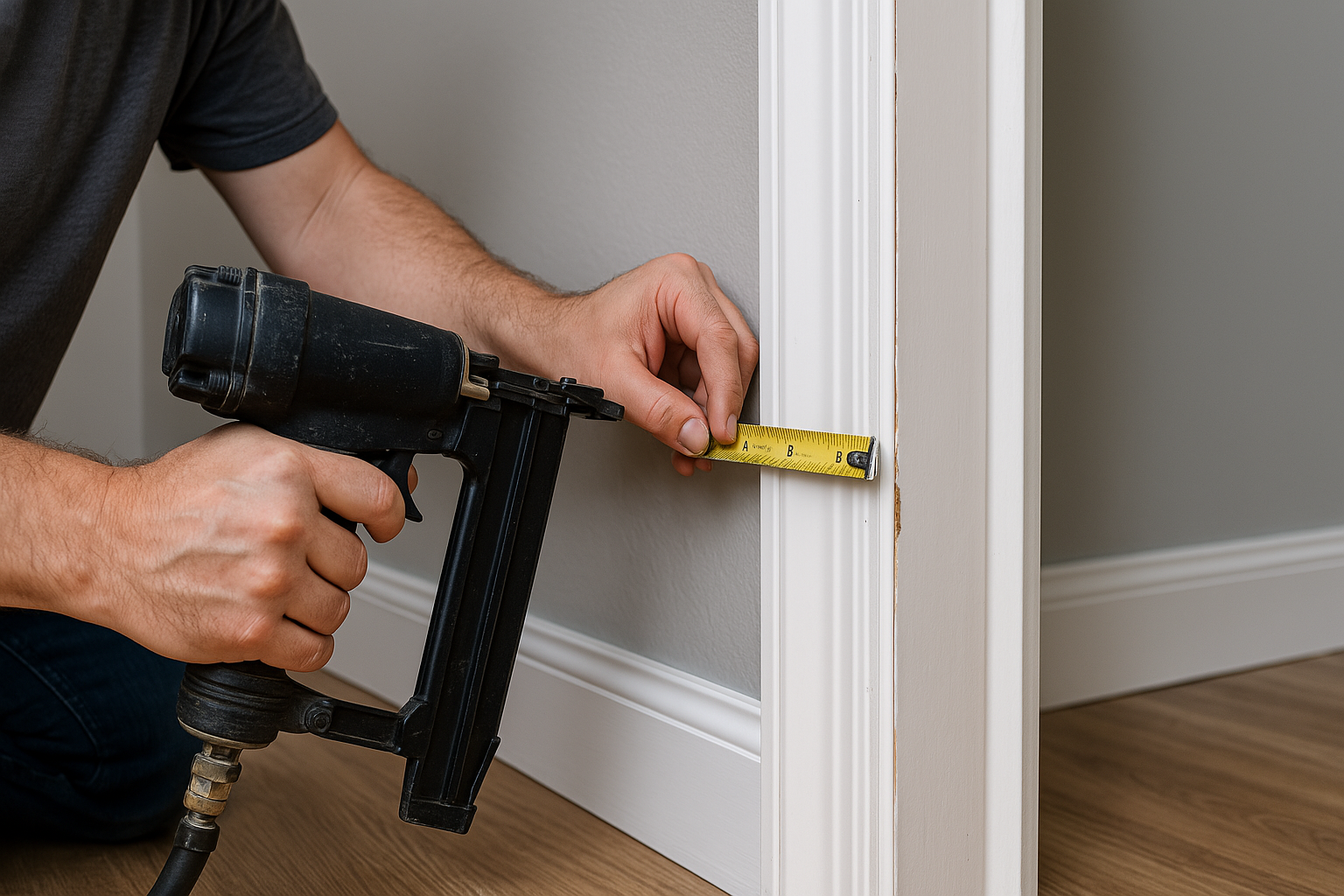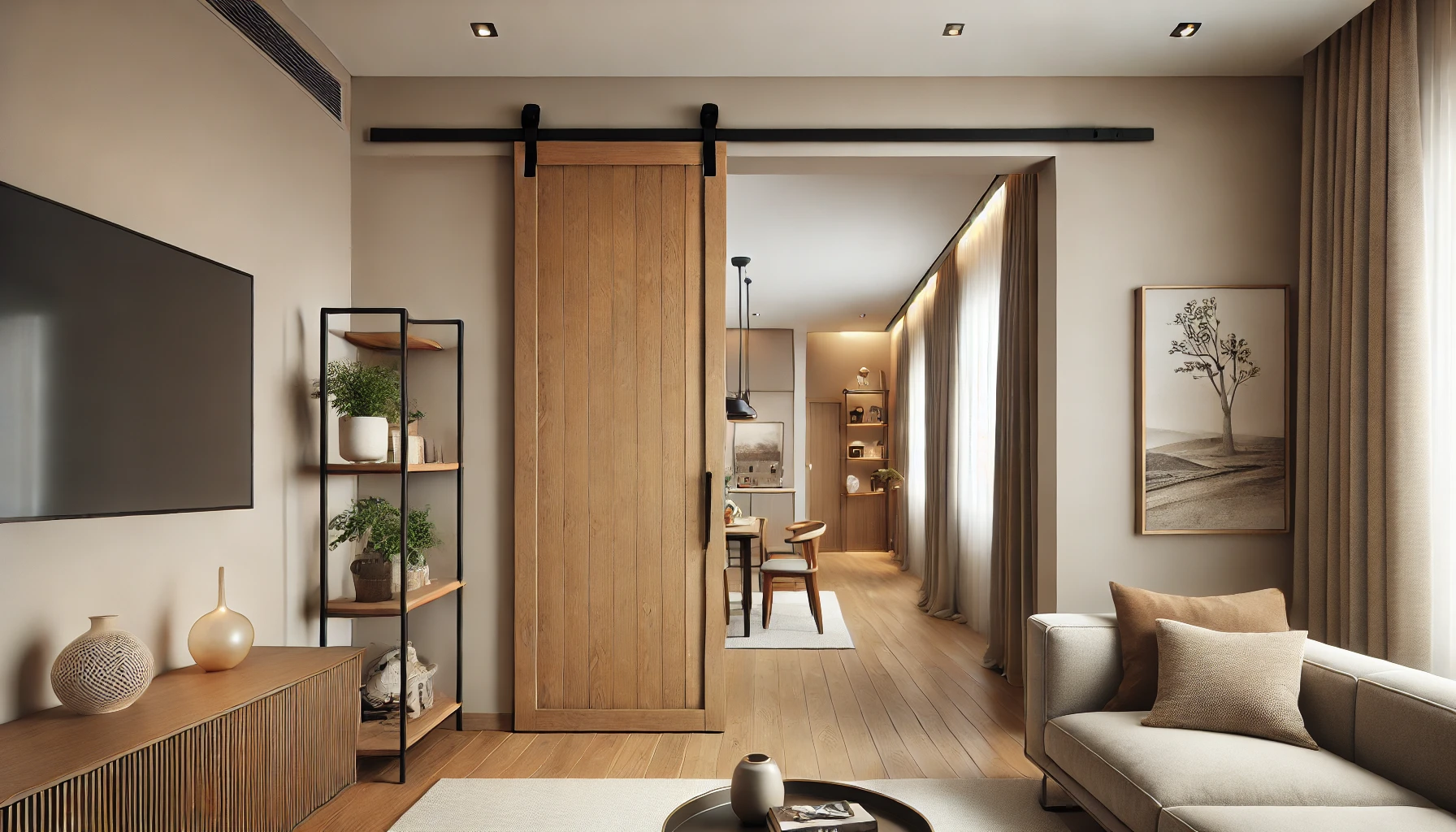The Best Interior Trim Materials
A Comprehensive Guide to Interior Trim Materials for Custom Homes and Renovations
Choosing the right interior trim materials for your home is crucial to achieving the perfect look and finish. Whether you are a custom home builder in the Toronto GTA, a homeowner planning a renovation, or a trade contractor collaborating on a project, understanding your options for interior trim can make all the difference. In this guide, we’ll dive into various trim materials, their features, and the best use cases to help you make informed decisions.
Trim not only adds elegance and detail but also elevates the craftsmanship of a space, ensuring it feels complete and polished. Let’s explore the best options and how they fit your unique needs.
1. Understanding Interior Trim Materials and their Purpose
Interior trim, also known as moulding, serves both decorative and functional purposes in homes. It frames doors, windows, floors, and ceilings, giving rooms a polished and finished look. The primary types of trim installation services include baseboards, crown moulding, door/window casings, and chair rails. Each has a specific purpose and contributes to the overall aesthetic and craftsmanship of a home.
For Trim Carpentry Contractors in Toronto, selecting the right trim materials is essential to bring out the character and craftsmanship that homebuyers expect. Likewise, for homeowners undergoing renovations, it’s a chance to refresh spaces with elegant touches that reflect personal style.
Types of Interior Trim Elements
There are several popular materials for interior trim, each with its own set of advantages, appearance, and suitability for different environments. Below, we’ll cover the most commonly used materials in interior trim and highlight which might work best for your projects.
2.1. Solid Wood as a Interior Finishing Material
Solid wood remains a classic choice for trim, prized for its natural beauty and versatility. Common woods include oak, pine, and poplar, each offering unique qualities that can fit various design aesthetics.
Oak: Oak trim provides a durable and attractive finish with prominent grain patterns. It’s ideal for creating a warm, traditional look.
Pine: A more affordable softwood option, pine is easy to work with and often used for painted trim work.
Poplar: Poplar is preferred for its smooth grain and workability. It’s an excellent choice if you plan to paint the trim since it holds paint well.
Use Case: Solid wood trim is best suited for luxury custom homes or areas where natural finishes are desired. It’s perfect for enhancing the warmth and sophistication of living rooms, dining areas, and entryways.
Pros:
- Timeless aesthetic appeal.
- Easy to sand, stain, or paint.
Cons:
- Expensive, especially for premium woods.
- Susceptible to moisture, making it less suitable for humid areas.
2.2. MDF (Medium-Density Fiberboard) is a Home Trim Material Favorite for Most DIYers
MDF is a highly popular alternative to solid wood for interior trim. MDF is engineered from wood fibers and resin, resulting in a smooth surface that’s easy to paint.
Use Case: MDF is an affordable option commonly used in new builds and renovations where cost efficiency is a priority. It’s a great fit for baseboards and crown moulding in painted finishes.
Pros:
- Cost-effective and budget-friendly.
- Smooth surface, ideal for painting.
- Resistant to warping and cracking.
Cons:
- Not as durable as natural wood.
- Susceptible to water damage if not sealed properly.
2.3. PVC (Polyvinyl Chloride)
PVC trim is made from plastic and has grown in popularity for specific applications, particularly in moisture-prone areas. It’s lightweight, resistant to mold, and highly durable.
Use Case: PVC trim works well in bathrooms, laundry rooms, and other areas prone to moisture. It’s also useful in modern or contemporary home designs due to its clean, consistent finish.
Pros:
- Waterproof, making it suitable for damp environments.
- Low maintenance.
- Easy to clean.
Cons:
- Limited aesthetic compared to natural wood.
- Cannot be stained; suitable only for painting.
2.4. Finger-Jointed Wood
Finger-jointed wood combines short pieces of wood joined together to create long trim boards. This material is often used for projects where painted trim is desired, providing an economical alternative to solid wood.
Use Case: Best used for budget-friendly projects where painted trim is the desired finish. It’s often used in mid-range renovations or for rental properties.
Pros:
- Less expensive than solid wood.
- Strong and stable.
- Environmentally friendly, reducing wood waste.
Cons:
- Joints may be visible over time.
- Not suitable for staining.
2.5. Polyurethane Foam Trim
Polyurethane foam trim is lightweight and easy to install, making it a popular choice for intricate mouldings such as crown and ceiling details. It’s resistant to moisture, making it ideal for both interior and exterior uses.
Use Case: Ideal for elaborate trim designs and for areas that require a lightweight and easy-to-handle material. It’s perfect for homeowners seeking elaborate crown moulding or custom ceiling medallions.
Pros:
- Easy to install, lightweight.
- Suitable for complex profiles.
- Moisture and insect resistant.
Cons:
- Can be more expensive than MDF.
- Prone to damage from heavy impact.
Factors to Consider When Choosing Interior Trim Materials
When selecting interior trim materials, it’s essential to consider factors like:
- Aesthetic Goals: Does your project call for a rustic, modern, or traditional look? Natural wood can bring warmth and character, while MDF offers a simple, painted look.
- Budget: Solid wood is more expensive, whereas MDF and finger-jointed wood can provide similar results at a lower cost.
- Durability: For high-moisture areas, materials like PVC or polyurethane are ideal.
- Ease of Installation: Contractors appreciate materials like MDF and polyurethane for their ease of handling, reducing labor time.
Interior Trim Materials Comparisons at a Glance
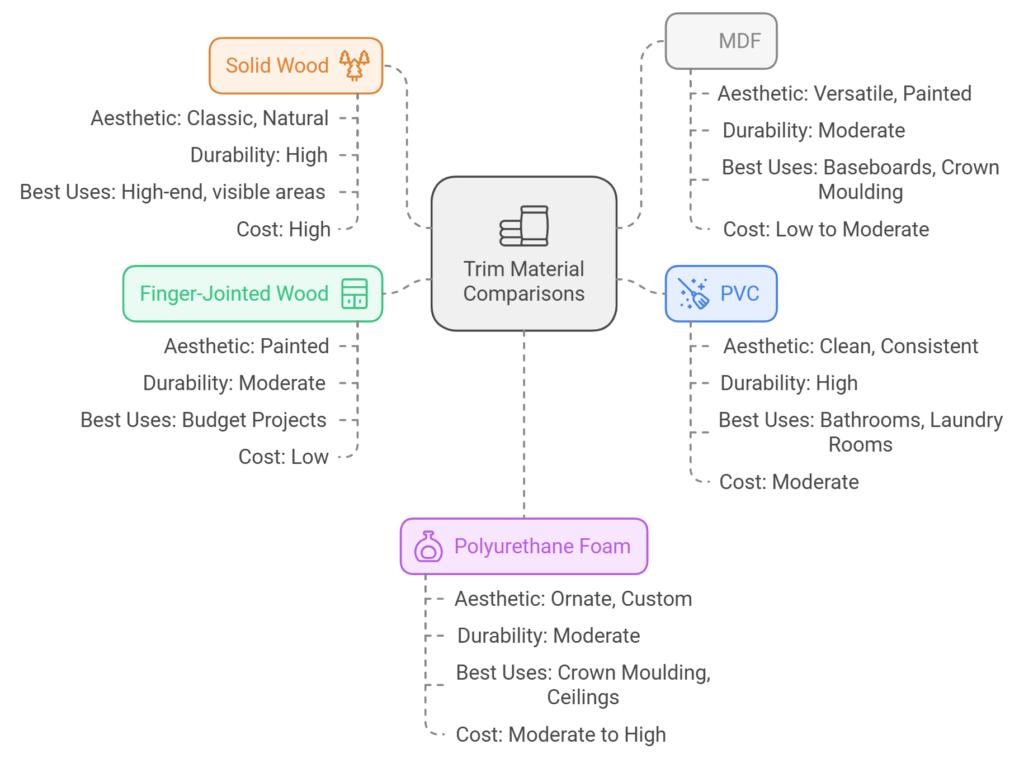
Expert Tips for Selecting and Installing Trim
- Consider Future Maintenance: Solid wood needs regular care if used in high-traffic areas, whereas materials like MDF and PVC are easier to maintain.
- Use Primer for MDF: Always prime MDF before painting to ensure a long-lasting finish.
- Match Trim Profiles: Consistency is key—make sure that the trim profiles complement each other throughout the house.
Recommended Resources for Further Reading
Here are some valuable resources to explore for more in-depth information on interior trim materials:
- HomeTips: Buying Interior Molding & Trim
- Overview: This guide offers insights into various types of interior trim, their applications, and material options.
- Pearl Painters: MDF vs. Wood Trim – Best Primer and Paint Options
- Overview: An in-depth comparison between MDF and wood trim, including recommendations for primers and paints.
- The Home Depot: Types of Moulding
- Overview: A comprehensive look at different moulding types, their uses, and material choices.
- Standard Companies: Exploring Different Interior Trim Styles and Materials
- Overview: This article delves into various interior trim styles and the materials best suited for each.
- Plan Forward: A Remodeler’s Guide To Interior Trim Moldings and Finish Carpentry
- Overview: A detailed guide focusing on interior trim moldings and finish carpentry techniques.
- Woodgrain: A Beginner’s Guide to Choosing the Perfect Trim and Moulding
- Overview: This beginner-friendly guide assists in selecting the ideal trim and moulding for various projects.
- Caroline on Design: A Guide to Interior Trim and Molding
- Overview: An informative piece on different interior trim and molding options, including materials and styles.
- Angi: Stained vs. Painted Trim
- Overview: This article compares stained and painted trim, discussing the pros, cons, and cost considerations of each.
- The Spruce: Use MDF, Wood, or Plastic for Baseboards and Trim?
- Overview: A comparative analysis of MDF, wood, and plastic materials for baseboards and trim applications.
- Better Homes & Gardens: 15 Types of Trim to Consider for Your Home Renovation
- Overview: An exploration of various trim types suitable for home renovation projects.
The Role of Trim in Toronto Homes
Architecture is characterized by a mix of historical styles and modern developments. Toronto Trim Carpenters and homeowners in the GTA often seek interior trim that not only aligns with their stylistic preferences but also adds a distinct sense of craftsmanship and quality to their homes.
Homeowners looking to renovate can make a significant impact by simply updating their trim, creating a cohesive look that elevates the entire room. When quality materials are paired with skilled craftsmanship, the results can be transformative.
Craftsmanship Meets Material Quality
The choice of interior trim materials will influence the overall look and durability of your project. Whether you opt for the natural beauty of solid wood, the affordability of MDF, or the moisture resistance of PVC, understanding your options helps you make informed decisions tailored to your project needs.
For custom home builders in Toronto or homeowners ready to start their renovation journey, the right trim can be the detail that brings a space from ordinary to exceptional. Consider your design goals, budget, and specific application to choose the best trim materials for your home.
Ready to Transform Your Space?
If you’re looking for expert trim installation services in Toronto, Miter5 is here to bring your vision to life with top-quality craftsmanship and personalized service. Contact us today to discuss your next project and see how we can make your interior spaces truly shine.
FAQ
Can I mix different trim materials in my home? Yes, mixing trim materials is a practical way to tailor your selections to each room’s unique needs. For example, using moisture-resistant PVC in bathrooms and budget-friendly MDF in bedrooms ensures that each space has the best-suited material for its environment, without compromising on style.
- Is solid wood worth the investment for interior trim?
Solid wood offers durability, a natural look, and the option to stain, making it a valuable choice for high-traffic or prominent areas like living rooms. While it’s more expensive, solid wood trim can enhance a home’s aesthetic and long-term value, especially if a classic, warm appearance is desired. - How can I make MDF trim look more high-end?
To elevate the look of MDF trim, apply a high-quality primer and paint with a semi-gloss or satin finish. For added elegance, consider using MDF for larger baseboards or crown molding to create a bold, refined look, especially in bedrooms or hallways where durability isn’t as critical. - Which trim material is best for high-humidity areas?
PVC and polyurethane are excellent choices for high-humidity areas like bathrooms and kitchens. PVC is completely water-resistant and mold-proof, while polyurethane is moisture-resistant and suitable for intricate moldings, making both ideal for spaces exposed to moisture.
5. Do I need a professional to install interior trim?
While DIY installation is possible with certain materials like MDF or finger-jointed wood, hiring a professional is recommended for complex trim, intricate designs, or moisture-prone areas where precise installation is crucial to prevent warping or damage.
Get a Free Quote
Learn How Miter5 Can Help with Your Trim Carpentry Projects

